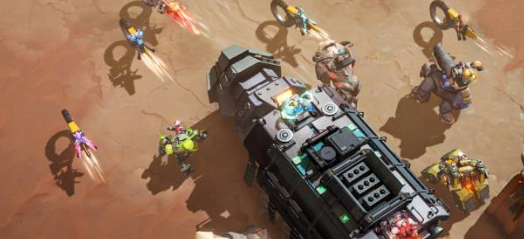MMOEXP Warborne Above Ashes:Supply Chains and Logistics at the Heart of Battle

In the world of military strategy games, few aspects are as crucial to success as the logistics chains and supply dynamics that support the front-line troops. In Warborne: Above Ashes, these elements take center stage, transforming what could be a WAA Solarbite simple strategy game into an intricate system of resource management, tactical deployment, and forward-thinking planning. Unlike traditional combat-heavy titles, Warborne: Above Ashes places a strong emphasis on supporting your forces, securing vital supply routes, and ensuring that your units stay well-equipped and ready for battle. Understanding how logistics operate within the game—and the front-line supply dynamics that come with it—is key to achieving victory.
This article delves deep into how logistics chains are set up, maintained, and disrupted in Warborne: Above Ashes, along with the strategic role that supply dynamics play in your army’s effectiveness. From securing vital resources to managing supply lines and forward-operating bases, this guide will help you understand the backbone of any successful campaign and how to maintain dominance on the battlefield.
1. The Backbone of Warfare: The Importance of Logistics in Warborne
In any military conflict, the logistics system is often as vital as the combat units themselves. The difference between victory and defeat frequently lies in how well a side can supply, maintain, and reinforce its troops. In Warborne: Above Ashes, this principle is taken to heart. The game takes place in a post-apocalyptic setting, where resources are scarce, and every supply drop or convoy is a lifeline for the player’s army. The core principle behind the logistics system in Warborne: Above Ashes is that without proper supply lines, even the most powerful forces can crumble under pressure.
The game introduces supply chains as an integral part of military operations. Players must ensure that their forces stay well-supplied with fuel, ammunition, food, medical supplies, and other critical resources. Logistics units, supply depots, and resource points are vital for maintaining these chains and ensuring that front-line units are properly equipped for combat.
2. The Structure of Logistics Chains
In Warborne: Above Ashes, logistics chains refer to the network of supply routes, depots, and vehicles that keep an army fueled, armed, and ready to fight. These chains are essential for both sustaining your forces during operations and preparing for long-term strategic success. The logistics system is multi-layered, requiring players to balance immediate needs with long-term sustainability.
A. Supply Depots and Resource Points
The first building block of any logistics chain in Warborne: Above Ashes is the supply depot. These are the central hubs from which all resources are distributed to your units. Players can establish these depots at critical locations, such as near forward operating bases (FOBs), airports, or military installations. The function of these depots is twofold:
Stockpiling Resources: Supply depots store critical resources like fuel, food, and ammunition. These are essential for keeping combat units operational. As units expend fuel or ammunition during engagements, they will need to resupply from these depots.
Resource Distribution: Once supply depots are set up, they act as distribution points that send resources to units on the front lines. These resources can be transferred through logistics convoys or supply drones, depending on the game mechanics.
B. Logistics Convoys and Supply Routes
Once a supply depot has been established, logistics convoys become the primary means of moving resources from the depot to the front lines. Convoys consist of a variety of vehicles, from trucks and armored transports to supply drones or even helicopter drop-offs in more rugged areas.
Convoy Composition: A typical convoy includes several vehicles carrying supplies, along with escort units to protect the convoy from enemy attacks. If a convoy is ambushed or delayed, your supply lines are severely compromised, leaving your front-line forces vulnerable.
Securing Supply Routes: To maintain a consistent flow of supplies, players must carefully consider how they secure supply routes. These roads, airways, or sea lanes are critical to the logistics chain, and they must be defended against enemy sabotage, ambushes, or environmental hazards. Players can assign patrol units or specialized reconnaissance teams to scout out and protect these routes.
The Risk of Supply Blockades: One of the more challenging aspects of managing logistics in Warborne: Above Ashes is dealing with potential supply blockades. Opponents can target key logistical hubs, disrupt supply lines, or cut off convoys. A well-timed attack on your logistics network can turn the tide of a battle, forcing you to stretch your limited resources or abandon certain fronts.
C. Forward Operating Bases (FOBs) and Field Supply Depots
For extended operations in hostile territories, setting up Forward Operating Bases (FOBs) is essential. FOBs are smaller supply depots set up near the front lines, allowing for quick resupply of troops operating in the field.
FOB Construction: Players can deploy engineers or construction units to build FOBs in strategic locations. These bases provide a range of services, including resupply, unit healing, and vehicle repairs. The placement of FOBs is often the deciding factor between success and failure on the battlefield, as it allows units to remain operational for extended periods without having to fall back to central supply depots.
Resource Storage and Distribution: Like main supply depots, FOBs store essential resources, but on a smaller scale. The cheap WAA Solarbite ability to re-supply ammunition, refuel tanks, or repair damaged vehicles on-site is a crucial part of sustaining offensive operations. Additionally, FOBs can be equipped with defensive structures (like turrets or barriers) to ensure the protection of these vital resupply points.
- Vibnix Blog
- Politics
- News
- Liberia News
- Entertainment
- Technology
- Education
- Art
- Causes
- Crafts
- Dance
- Drinks
- Film
- Fitness
- Food
- Games
- Gardening
- Health
- Home
- Literature
- Music
- Networking
- Other
- Party
- Religion
- Shopping
- Sports
- Theater
- Wellness


